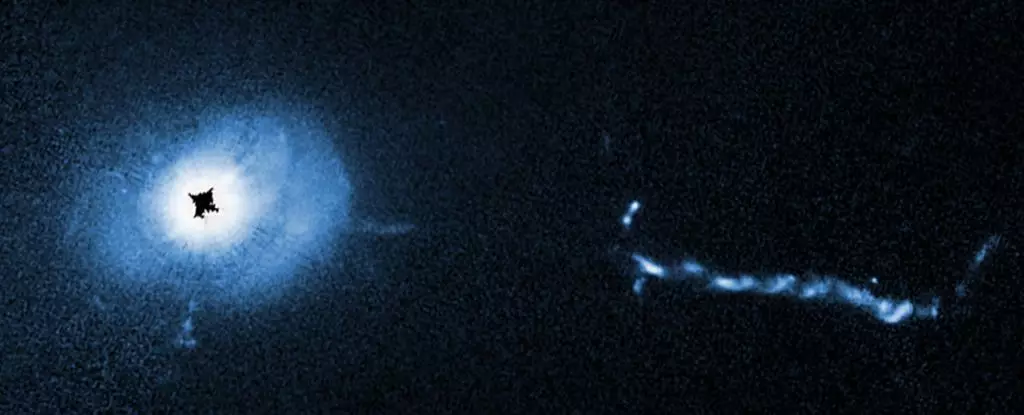The universe is home to many fascinating celestial phenomena, but few compare to the allure and complexity of quasars. Recently, astronomers utilizing the Hubble Space Telescope have directed their focus on quasar 3C 273, a luminary lying approximately 2.5 billion light-years away from Earth. This quasar shines brighter than nearly all its cosmic siblings, ranking among the closest quasars to our planet while providing invaluable insights into the mechanics of these elusive beings. The latest observations have unveiled intricate structures never before discerned, not only expanding our knowledge about this specific quasar but also validating a new methodology for studying the enigmatic nature of quasars.
Quasars, or quasi-stellar objects, are among the most extraordinary bright entities in the universe, surpassed only by gamma-ray bursts and supernovae. The intense brightness of a quasar originates from a supermassive black hole at the center of a galaxy. Unlike conventional celestial bodies, black holes themselves emit no light; rather, their radiance stems from surrounding gas and dust. As these materials spiral into the black hole, they form an accretion disk that becomes increasingly turbulent due to gravitational forces and friction. This process results in heating the material to extreme temperatures, causing it to emit light across a broad spectrum. It is this dazzling energy that allows us to observe quasars from billions of light-years away.
Despite the wonders they represent, quasars are often located at great distances, where even the nearest ones remain nearly blinding in their brightness, which complicates efforts to resolve their individual features. Although not the closest quasar, 3C 273 stands out due to its remarkable brightness, which is equivalent to trillions of suns combined. This attribute permits even amateur astronomers to view it with relatively simple telescopes.
To further investigate the intricate details of 3C 273, astronomers employed a sophisticated observational strategy utilizing the Hubble’s Space Telescope Imaging System (STIS). This approach employed a virtual coronagraph, which functions as an effective shield against direct light, allowing researchers to isolate finer structural details within the glare. This technique can be likened to shielding one’s eyes from intense light; it enhances visibility and reveals elements hidden within the brightness.
The recent observations conducted by Hubble are eight times more precise than previous data and have unveiled a striking array of features in an area spanning 16,000 light-years from the quasar’s core. During this investigation, researchers identified small masses that could represent either satellite galaxies or fragments of material gravitationally influenced by the quasar’s might. Among the noteworthy discoveries is the presence of a new core jet and an enigmatic L-shaped filament yet to be classified. These findings enrich our understanding of quasars’ complexity and the forces at play within their surrounding environments.
Moreover, the intricate measurements derived from the analysis of the astrophysical jet, propelled by the black hole’s magnetic field, extend an astonishing 300,000 light-years into intergalactic space. This observation over a 22-year period disclosed that the jet’s velocity appears to increase with distance from the black hole, a phenomenon that warrants further investigation to decipher its underlying mechanisms.
Understanding these findings is crucial, as they represent a significant step toward cultivating a more comprehensive knowledge of both 3C 273 and quasars as a category. The evolution of observations from Hubble has facilitated a bridge between existing research methodologies—specifically, the small-scale radio interferometry and broader optical imaging—thus paving the way for deeper exploration into the holistic morphology of quasars and their interactions with their host galaxies.
As astronomers process the data derived from Hubble’s observations, they stand on the brink of potentially transformative insights regarding the intricate relationships between quasars and their galactic environments. “Thanks to Hubble’s observational prowess, we are opening a new chapter in the exploration of quasars,” notes Bin Ren, an astronomer at the Côte d’Azur Observatory. With Hubble’s unique capabilities, researchers can probe deeper into the features and traits of quasars, which promises to dramatically enhance our grasp of the complexities within these powerful cosmic entities.
The study of quasar 3C 273 exemplifies the ever-evolving pursuit of cosmic knowledge and the remarkable technological advancements that continue to unlock the doors to the universe’s mysteries. As astronomers delve into these profound discoveries, the cosmos unveils not only new data but also deeper questions that will inspire generations of scientists to come. The realm of quasars remains open for exploration, promising a rich tapestry of discoveries waiting to be unraveled.

